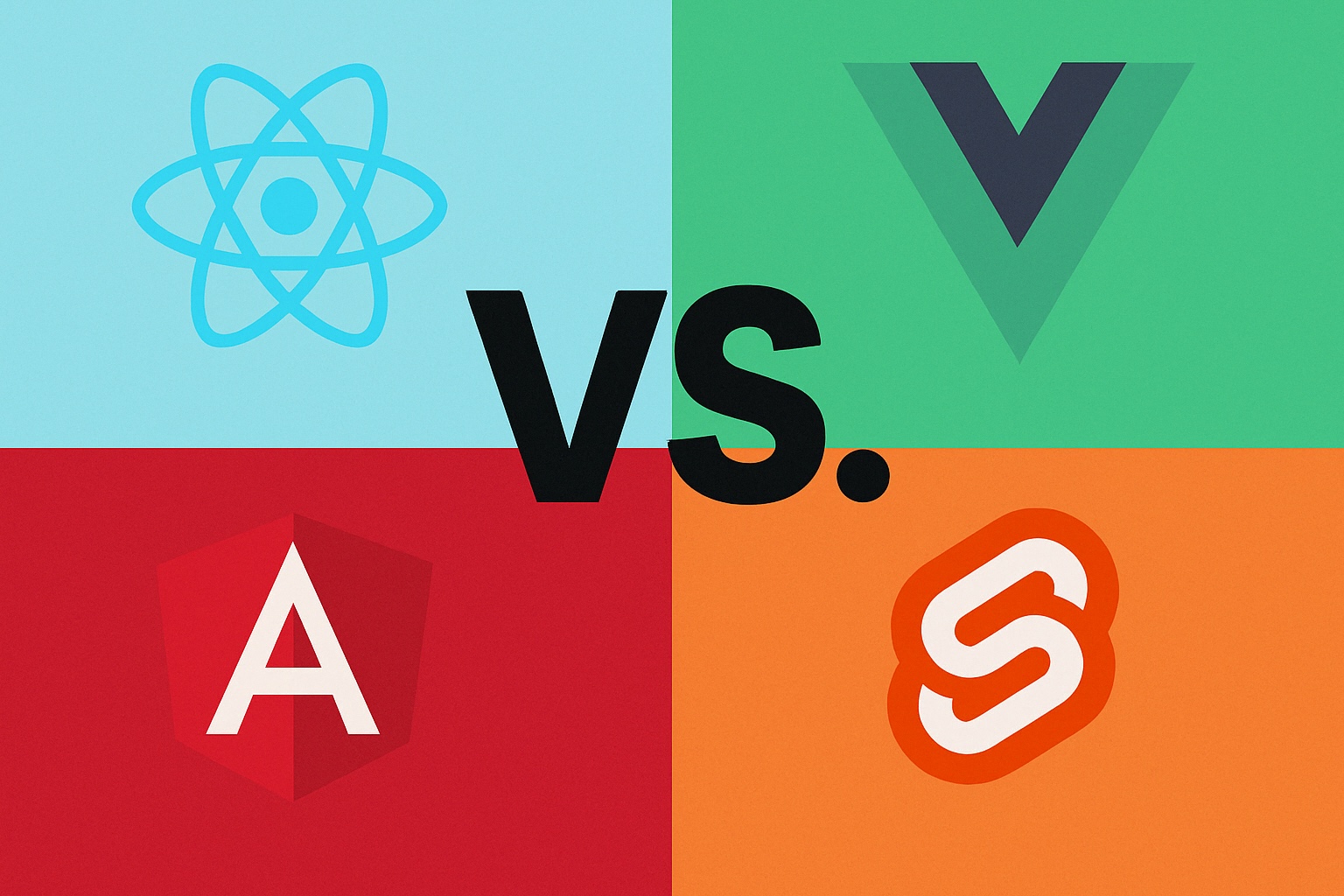React vs. Vue vs. Angular vs. Svelte: The Battle of the JavaScript Giants
As developers, we often have a preferred framework or library that we turn to for our projects. Whether it’s building user interfaces, managing state, or optimizing performance, there’s always a favorite!
Here’s a quick overview of each of the four JavaScript libraries/frameworks:
1. React
- Created By: Jordan Walke initially later by the Facebook team
- Core Idea: React is a library for building user interfaces. It focuses on creating reusable UI components, making it easier to manage and scale large applications. React allows developers to build single-page applications (SPAs) with a dynamic, fast user experience by using a virtual DOM to minimize direct interaction with the real DOM.
- Key Features: Component-based architecture, JSX (JavaScript XML), Virtual DOM, and a large ecosystem (including libraries like React Router, Redux, and more).
2. Vue.js
- Created By: Evan You
- Core Idea: Vue.js is a progressive framework that was initially heavily inspired by Angular.js, later it became a behemoth itself. It’s designed to be incrementally adoptable, meaning it can be integrated into projects gradually. Vue is often praised for its simplicity and ease of learning, making it a great choice for both beginners and experienced developers.
- Key Features: Two-way data binding, directives, reactive data, and a highly customizable ecosystem with tools like Vue Router and Vuex for state management.
3. Angular
- Created By: Google
- Core Idea: Angular is a full-fledged framework that provides a complete solution for building large-scale applications. Angular previously known as Angular.js revolutionized two way data binding. It’s opinionated about the structure and flow of your code and comes with built-in features like routing, form validation, HTTP client, and more. Angular is designed to support complex, enterprise-level applications.
- Key Features: Dependency injection, two-way data binding, First class TypeScript support, modular architecture, RxJS for handling asynchronous operations.
4. Svelte
- Created By: Rich Harris
- Core Idea: Svelte takes a different approach compared to React, Vue, and Angular. Instead of running in the browser as a framework, Svelte shifts the work to compile time. This means it generates highly optimized vanilla JavaScript code that runs faster with minimal overhead, leading to excellent performance in production. Svelte is elegantly simple to use and learn. It’s my favorite JS framework to work with.
- Key Features: Compile-time optimization, no virtual DOM, reactive statements, and simple syntax. Svelte applications are typically faster and smaller than traditional frameworks. With svelte 5 they introduced runes far better state management mechanism and its popularity is growing day by day.
Popularity
React is currently the most popular JavaScript library/framework among the four. Here’s a breakdown of their popularity:
1. React
- Popularity: React leads the pack in terms of usage and community support. It has a huge ecosystem, extensive documentation, and is widely used by companies like Facebook, Instagram, Netflix, and Airbnb. According to Stack Overflow’s Developer Survey, React has been the most popular library for several years.
- Why it’s popular: React’s simplicity, flexibility, and vast community make it an appealing choice. Its component-based architecture allows for reusable code, and the large number of available tools and libraries further enhance its adoption.
2. Vue.js
- Popularity: Vue has seen rapid growth, particularly among individual developers and small to medium-sized companies. While it’s not as popular as React, it’s gaining ground quickly and is particularly loved for its simplicity and flexibility.
- Why it’s popular: Vue provides an easy learning curve and offers an approachable design that allows developers to get started quickly. It’s often seen as the perfect middle ground between React and Angular.
3. Angular
- Popularity: Angular has a strong presence, especially in enterprise-scale applications. However, its complexity compared to React and Vue has made it less popular among individual developers and startups.
- Why it’s popular: Angular is a comprehensive, full-fledged framework with many built-in tools, making it perfect for large, complex applications. Companies that require structure and robust tools often opt for Angular.
4. Svelte
- Popularity: Svelte is the newcomer in the race. It’s gaining a lot of attention due to its unique approach to building apps and its performance advantages. While it’s not as widely adopted as the others, it has a rapidly growing and passionate community.
- Why it’s popular: Svelte’s compiler-based approach results in faster applications with minimal runtime overhead. Its simplicity and performance benefits have made it a favorite among developers looking for something fresh and efficient.
In summary:
- React is the most popular and widely used.
- Vue is growing quickly, especially among developers looking for simplicity.
- Angular is popular in large, enterprise-scale applications.
- Svelte is a rising star, gaining attention for its performance and unique approach.
For now, React is the dominant choice, but Vue and Svelte are rapidly gaining popularity in their own right. You will see the React’s dominance in action in AI tools like v0.dev, loveable and bolt.new, write a prompt to build something, 99% of the time it will build it using next.js which is a React.js meta framework.
